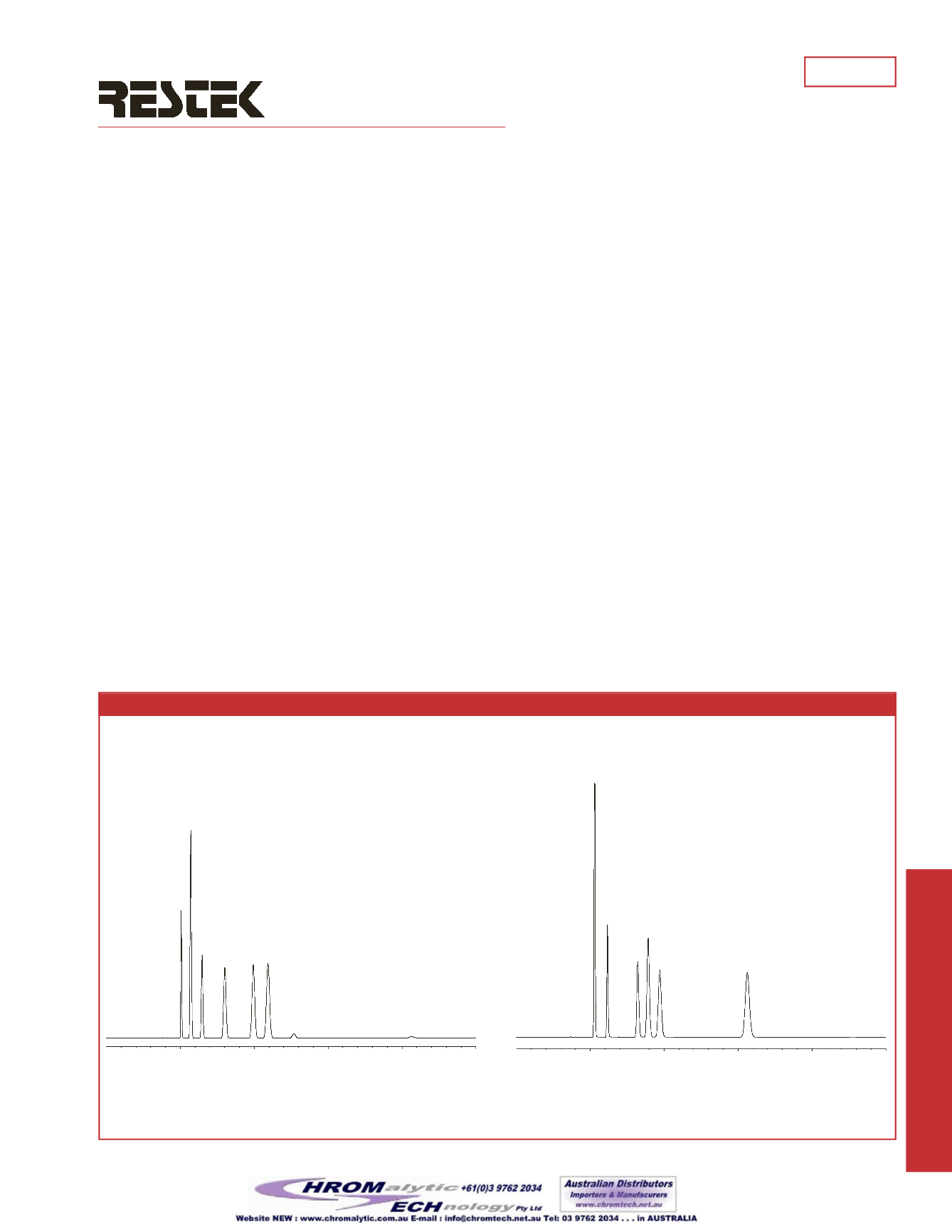
clinical/forensic
Applications
note
Restek Corporation • (800) 356-1688 •
#59548
clinical/forensic
GCAnalysis of CommonlyAbused Inhalants inBloodUsing
Rtx
®
-BAC1 andRtx
®
-BAC2Columns
30m, 0.53mm ID, 3.0µmRtx
®
-BAC1 (cat.# 18001) and 30m, 0.53mm ID, 2.0µmRtx
®
-BAC2 (cat.# 18000). 1.0mL headspace sample;
Oven temp.:
40°C (hold 5min.) to 240°C@ 5°C/min.;
Inj. &det. temp.:
240°C;
Carrier gas:
He;
Linear velocity:
65cm/sec.
1. methanol
2. acetaldehyde
3. ethanol
4. isopropanol
5. acetone
6.
n
-propanol
min. 1
3
2
6
5
4
3
2
1
min. 1
3
2
1
65 4
3
2
Rtx
®
-BAC1
Rtx
®
-BAC2
Inhalant abuse is the intentional concentration and inhalationof
volatile compounds found in commercial products. In recent years,
inhalant abuse has become themethodof choice for first-time
drugusers. In1993, the average age for first-time inhalant abusers
was 10.8years, whereas the average age for first-time abusers of
other drug substanceswas 12.5years. In fact, almost 20%of
eighthgrade students have abused inhalants. Chronic inhalant
abuse can lead to respiratory, cardiovascular, liver, andkidneydis-
ease.Acute respiratory and cardiovascular responses to inhalant
abuse also canproduce inhalant-induced suddendeath syndrome.
1
Inhalant abuse can be detected during screening ofwhole blood,
serum or urine samples using headspace gas chromatography
(GC) combinedwith flame ionization detection (FID). For this
application, aGC equippedwith an automated headspace sampler
that simultaneously introduces a sample into two analytical
columnswas used.A dual-column configuration provides screen-
ing and confirmational data from the same injection.We used the
Rtx
®
-BAC1 (30m, 0.53mm ID, 3.00µm df) and theRtx
®
-BAC2
(30m, 0.53mm ID, 2.00µm df) columns—typically used in com-
bination as a screening and confirmational column set for blood
alcohol analysis.A useful extension of blood alcohol analysis
using this column set is the detection of other volatile organic
compounds (VOCs), such as those found in inhalants.
Optimal performance of these columns duringheadspace analysis
depends onproperGC/headspace system set-up. Bandbroadening
canoccur if there is excess deadvolume in the sample flowpath
prior to the sample reaching the headof the column. Low-volume
inlet sleeves or injectionport interfaces significantly reduce the
amount of excess volume at the exit endof the transfer line and
will help tomaintainnarrow symmetrical peak shapes. Higher car-
rier gas flow rates through the transfer line also are important in
maintaininggoodpeak shape. Our experiments showed that carrier
gas flow rates between15 and25mL/minutewere themost effi-
cient for transferring the sample from the headspace sampler to the
headof the column in a tight sample bandwidth.
The following classes of commonlyabused inhalant com-
poundswere analyzed todetermine retention times for each
compound.
BloodAlcoholAnalysis
Although ethanol is not commonly abused as an inhalant, it is the
primaryvolatile substance detected in screening for volatile organ-
ic compounds as a result of alcoholic beverage ingestion. Other
compoundsmonitoredduringblood alcohol analysis include low
molecularweight alcohols and theirmetabolites (Figure 1).
4
5
4
5
Figure 1
Baseline resolution on the Rtx
®
-BAC1 andRtx
®
-BAC2 columns for all compounds tested for during blood alcohol screening.


